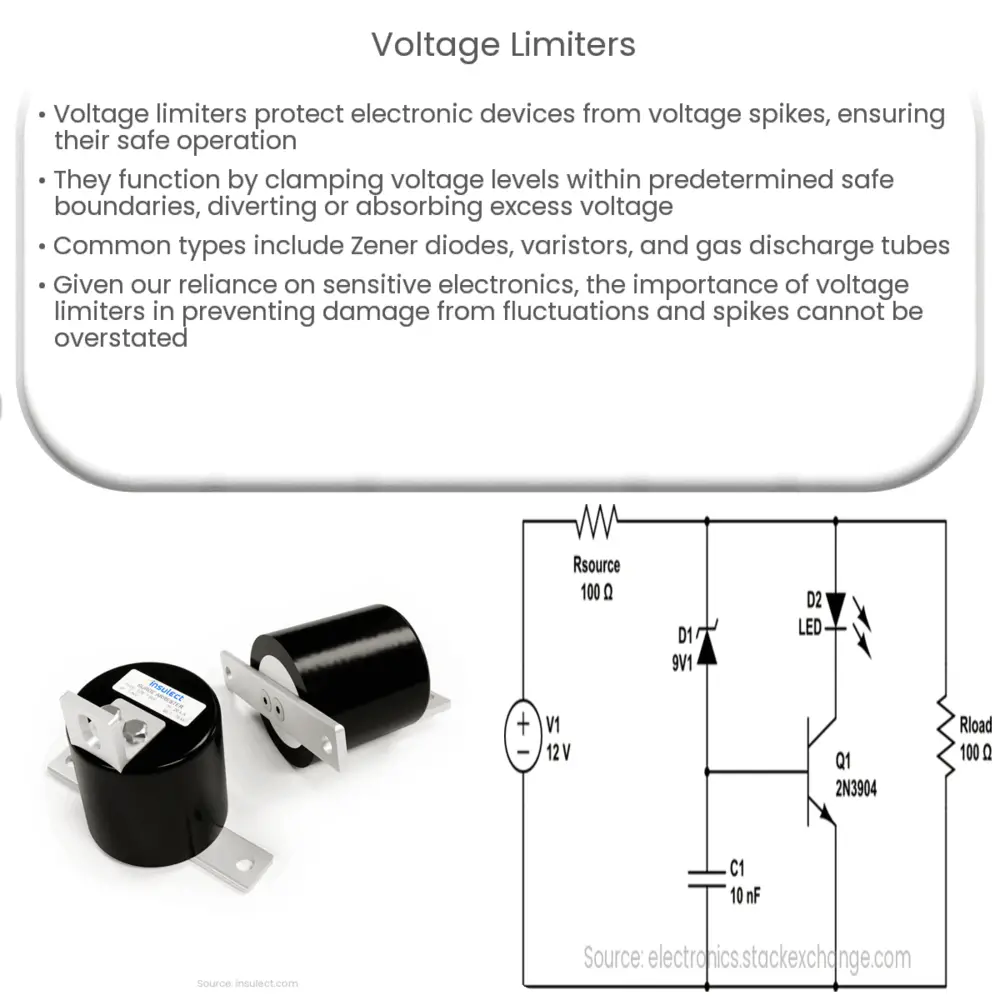Explore the vital role of Voltage Limiters in protecting electronic devices from voltage spikes, understand their types, working principles, and applications.

Introduction to Voltage Limiters
In the realm of electronics, safeguarding devices from voltage spikes is an essential task. One crucial component used in accomplishing this protection is a Voltage Limiter. Voltage limiters, also known as voltage clamps, play a vital role in ensuring the safe operation of electronic devices by limiting voltage spikes to a particular level.
Understanding Voltage Limiters
Voltage limiters are electronic devices or circuits designed to limit or clamp voltage levels within predetermined safe boundaries. The principle on which these devices work is simple: when the input voltage exceeds the threshold level, the limiter acts, and the excess voltage is diverted or absorbed, thus preventing damage to the circuit or device. Different types of voltage limiters, including Zener diodes, varistors, and gas discharge tubes, are employed based on the specific application and requirements.
- Zener Diodes: These are often used as voltage limiters by exploiting their voltage regulation properties in the breakdown region.
- Varistors: These components exhibit a non-linear resistance, which changes with applied voltage. They are commonly used to protect against high transient voltage spikes.
- Gas Discharge Tubes: These are specifically designed to handle high voltage transients, typically used in telecommunication systems and power supply networks.
Importance of Voltage Limiters
The need for voltage limiters cannot be overstated, especially considering the increasing dependence on sensitive electronic devices in our day-to-day lives. These devices can be vulnerable to voltage fluctuations and spikes, which can result from various sources such as lightning strikes, power surges, or switching transients. A high voltage transient can lead to serious damage such as component failure or data loss. Here, voltage limiters play an essential role in protecting these devices.
Working Principle of Voltage Limiters
Voltage limiters work on the principle of ‘clamping’ the voltage, that is, they limit the voltage to a specific value. When the voltage exceeds the specified limit, the voltage limiter either redirects the excess voltage or absorbs it. This is accomplished through the unique characteristics of the components used in the limiter, such as Zener diodes, varistors, or gas discharge tubes.
Without getting too far into the technical details, the basic operation involves the limiter transitioning from a high impedance state to a low impedance state when the voltage threshold is exceeded. This ‘switching’ behavior ensures that the voltage across the device doesn’t rise above a specified level, thus protecting the rest of the circuit.
Applications of Voltage Limiters
Voltage limiters have a wide range of applications, and you’ll often find them in devices and systems where voltage spikes can be harmful. Some common applications include:
- Power Supply Systems: Voltage limiters are commonly used in power supply systems to prevent voltage spikes that can damage equipment and disrupt operations.
- Telecommunications: In telecommunications, voltage limiters protect sensitive communication equipment from transient voltages.
- Consumer Electronics: Devices like televisions, computers, and gaming consoles often use voltage limiters to safeguard against power surges that could cause damage.
- Industrial Machinery: Industrial equipment often incorporates voltage limiters to protect against electrical faults that could lead to machinery failure.
Selection and Usage of Voltage Limiters
Choosing the right voltage limiter depends on various factors including the type of device or system being protected, the nature of the potential voltage spikes, and the specific requirements of the application. Factors such as the response time, clamping voltage, energy rating, and maximum current capacity of the limiter are important considerations. Therefore, it’s essential to understand these specifications and select a limiter that best fits the application’s needs.
While voltage limiters provide excellent protection against transient voltages, it’s important to remember that they should be used in conjunction with other protective measures for comprehensive protection. Regular equipment maintenance, proper grounding, and surge protection devices all play a role in maintaining the integrity of electronic systems.
Conclusion
In conclusion, voltage limiters are an essential component in electronic devices and systems, providing a robust line of defense against potentially damaging voltage spikes. By understanding their working principles, types, applications, and selection criteria, we can leverage their protective qualities and enhance the reliability and longevity of our devices. Despite their significance, they are just one piece of the puzzle in the broader context of electrical protection, underlining the importance of a comprehensive, multi-layered approach to safeguarding electronic equipment.

